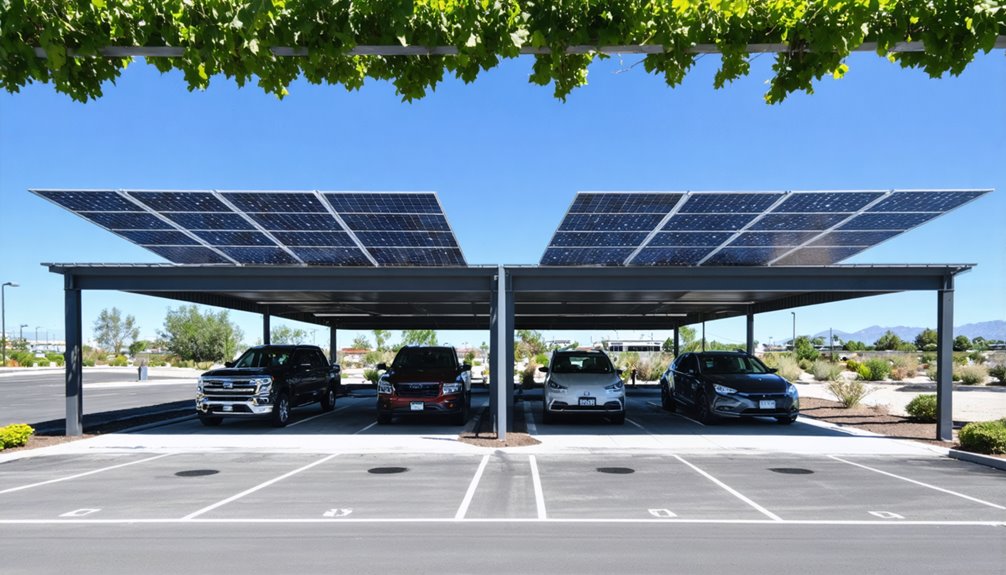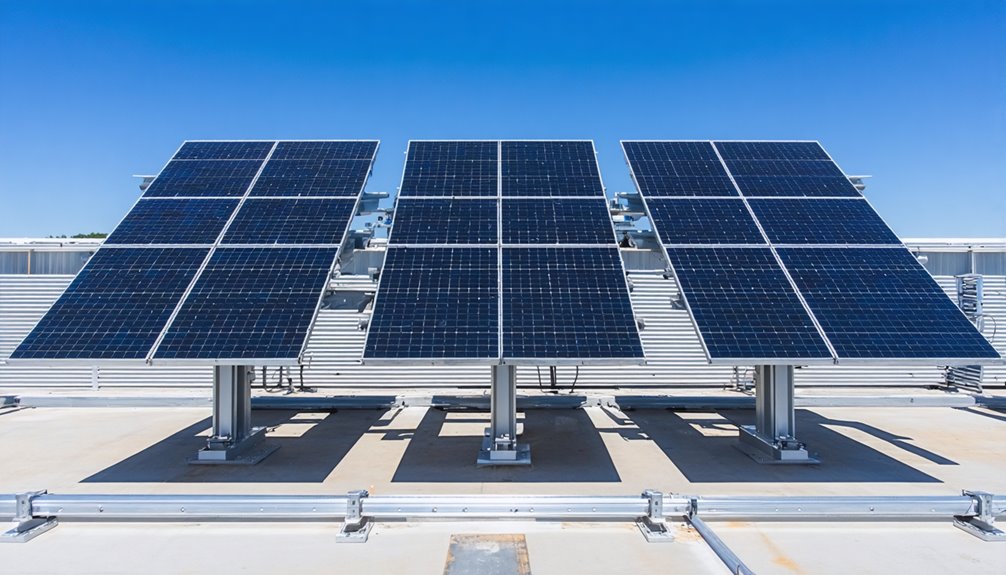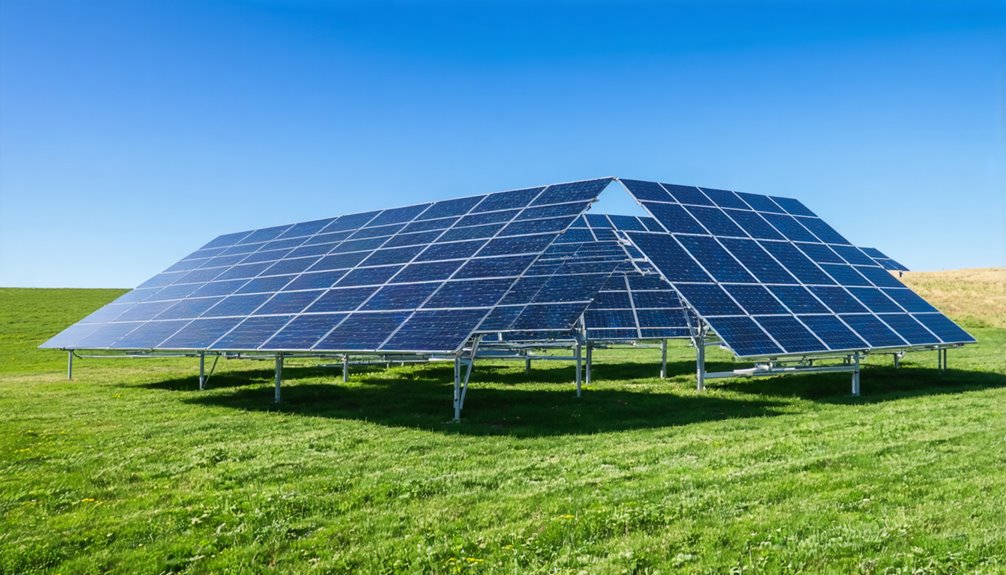Solar panel mounting structures maximize energy efficiency by securely supporting panels in various environments like rooftops, ground sites, and water bodies. These structures include rooftop systems with hooks or rails, cost-effective and efficient fixed-tilt ground systems, and space-saving floating systems that double as cooling surfaces. Other options like pole mounts and carport structures optimize land usage, while advanced solutions like tracking systems and Smartflower mounts enhance solar capture. Discover more about optimizing your solar investment.
Understanding Solar Panel Mounting Structures
Solar panel mounting structures play an essential role in the effective deployment of solar energy systems by providing secure placement, enhancing the angle and orientation for maximum sunlight absorption, and safeguarding panels against adverse environmental conditions such as wind and snow. Understanding solar mounting structures is vital for maximizing energy capture, whether you’re installing rooftop or ground-mounted solar panels. There are various types of solar mounting configurations, each tailored to different environments. Ground-mounted solar panels typically feature a fixed angle or tracking options, ensuring ideal exposure throughout the day. The installation process varies based on the system type, impacting both the efficiency and overall cost. Durable materials, such as galvanized metal or steel, extend the life of mounting structures, aligning their longevity with that of solar panels. All mounting solutions are engineered to meet wind load requirements and resist weather exposure.
Rooftop Mounting Structures
Rooftop mounting structures serve as a practical solution for utilizing existing spaces on residential or commercial buildings, they also offer significant advantages regarding installation efficiency and space efficiency. Rooftop mounting structures provide an efficient method for solar panel placement, especially on concrete roofs, reducing the need to occupy valuable ground. This type of installation is cost-effective, with installation costs around Rs. 8/kW, and facilitates simpler maintenance due to ventilation beneath the panels. When considering rooftop installations, it’s essential to evaluate the roof’s age, structural integrity, and possible water leaks from drilling. You can choose from on-roof systems using metal hooks and rails or in-roof systems for a more integrated look. Ideally, the structure’s lifespan should align with the solar panels lifespan, ensuring longevity. Additionally, ensure safety and code compliance by conducting structural calculations to match local wind loads and permits.
Ground Mounting Structures
In ground mounting structures, you can choose between fixed-tilt systems, which offer cost-effectiveness and simplified installation due to their static design, and tracker systems, which enhance energy efficiency by following the sun’s movement with either single-axis or dual-axis configurations. Fixed-tilt systems, while more budget-friendly and less complex to set up, may produce slightly less energy compared to tracker systems, which invest in dynamic positioning for increased solar capture throughout the day. These options allow you to maximize energy yield, with ground-mounted panels generally achieving higher efficiency than their rooftop counterparts by utilizing ideal tilt angles and robust, durable components that guarantee long-term stability and minimal environmental impact. This comparison is a core aspect of ground mounting systems.
Fixed-Tilt Cost Benefits
Fixed-tilt ground mounting structures offer significant cost advantages for large-scale solar installations, as they bypass the substantial expenses linked to more complex tracking systems. These structures are cost-effective, with installation processes that save 20%-30% in labor costs due to reduced engineering and design complexity. Their stable angle guarantees peak energy production by maximizing sunlight exposure, eliminating the need for moving parts, which simplifies maintenance and enhances durability. Designed to withstand various environmental conditions, fixed-tilt systems align with the 25-30 year lifespan of solar panels, offering long-term reliability. With easier maintenance compared to tracking systems, they result in lower ongoing operational costs, making them a favorable option for minimizing the total cost of ownership in solar energy projects.
Tracker Systems Efficiency
Tracker systems, frequently enhancing the efficiency of ground-mounted solar installations, enable panels to follow the sun’s trajectory, potentially boosting energy production by up to 25% compared to stationary systems. Ground-mounted systems using tracker technology implement either single-axis or dual-axis designs. Single-axis trackers rotate east to west, offering an efficient and cost-effective solution, whereas dual-axis trackers adjust vertically and horizontally, maximizing energy production by optimizing sun exposure throughout the year. Despite the efficiency gains, they require a notable 60% higher initial investment than fixed systems. However, their elevated energy output can justify the extra expense over time. Regular maintenance is essential for these systems due to their increased mechanical complexity, ensuring long-term operational efficiency and reliability in energy production.
Floating Mounting Structures
In exploring floating mounting structures, you’ll find they take advantage of still water bodies like lakes and reservoirs to maximize land space while benefiting from a natural cooling effect that can boost solar panel efficiency by up to 10%. These systems not only enhance energy generation but also contribute positively to environmental efforts by reducing water evaporation and slowing algae growth, though they require careful planning to mitigate impacts on aquatic ecosystems and to manage wave dynamics. As these installations grow at a rate of about 35% annually, it’s crucial to evaluate both the advantages of water cooling and the engineering challenges they present.
Benefits of Water Cooling
Floating mounting structures on still water bodies offer several significant benefits by employing the natural cooling effect of water, which enhances solar panel efficiency beyond that of traditional ground or rooftop installations. Floating solar systems leverage water cooling, reducing panel temperatures and consequently increasing solar panel efficiency and energy output by 10-15%. They present critical solutions in regions facing drought by minimizing water evaporation and alleviate land use conflicts by utilizing untapped water surfaces. Furthermore, they help control algae growth by covering the water surface and promoting sunlight penetration. Here’s a look at the primary benefits:
| Benefit | Impact |
|---|---|
| Increased solar efficiency | 10-15% higher energy output |
| Drought mitigation | Reduces reservoir evaporation |
| Land conservation | Avoids land use conflicts in populated areas |
| Algae control | Limits growth by shading and sunlight access |
Environmental Considerations and Challenges
While floating mounting structures bring a fresh perspective to solar energy deployment, they also present unique environmental considerations and challenges that require thorough analysis. Floating solar installations offer renewable energy benefits by optimizing solar panel efficiency through natural water cooling and reducing land use pressure. However, environmental challenges arise, such as potential impacts on water quality and local aquatic ecosystems, including disrupting fish habitats. Engineering considerations require ensuring stability and structural integrity against elements like high winds or fluctuating water levels. It’s essential to select sites that minimize harm to aquatic ecosystems, balancing structural needs with environmental preservation. As floating solar technology expands, addressing these challenges is important for responsible integration into broader renewable energy strategies.
Pole Mounted Structures
Among the various types of solar panel mounting structures, pole-mounted systems stand out for their unique design and functionality, supporting solar panels on a single pole, which is especially effective for private properties or agricultural lands. These pole-mounted solar structures maximize space for energy generation and can incorporate tracking systems to enhance energy production efficiency by allowing panels to follow the sun throughout the day. Maintenance is simpler due to their elevation, reducing debris risks and providing easy access to guarantee peak performance. While they offer several advantages, it’s essential to adapt these systems to local environmental conditions and site-specific installations to address potential shading issues and structural risks associated with storms, given their limited capacity compared to ground-mounted or rooftop systems. Pole-mounted tracking systems can further boost energy production when properly aligned with the sun.
Carport Solar Module Mounting Structures

Carport solar module mounting structures provide an innovative solution for harnessing solar energy while offering additional functionality, such as shading vehicles parked beneath them. Installed over parking lots, these structures not only contribute to energy production, considerably reducing electricity bills—potentially to zero—but also enhance a property’s utility. The design of a carport requires careful consideration of structural stability and ideal panel orientation to guarantee maximum energy output. Although the upfront installation costs for these mounting structures are higher than for standard rooftop systems, their dual functionality offers additional value. By integrating electric vehicle charging stations, carport solar modules further support sustainable transportation options, making them a forward-thinking choice for property owners looking to maximize both energy efficiency and space utilization. Ground-mounted carport structures also capitalize on optimal tilt and orientation to maximize energy production.
Smartflower Mounting Structures
Incorporating both aesthetic and functional elements, Smartflower mounting structures offer an innovative solar energy solution that uses an automated solar tracking system designed to maximize energy efficiency. With a flower-like design, these systems utilize a dual-axis mechanism to follow the sun’s path throughout the day, adjusting both horizontally and vertically to capture prime sunlight. While they may come with a higher initial investment than traditional systems, their self-contained design and eye-catching appearance provide both practical benefits and visual appeal for residential and commercial installations.
Automated Solar Tracking
While the Smartflower mounting structures present an aesthetic and innovative approach to solar energy capture, their dual-axis tracking mechanism is their most notable feature, as it allows the panels to mimic the movement of a flower by opening up during the day to optimize sun exposure and closing at night for protection. This automated solar tracking enhances energy capture efficiency by ensuring the panels follow the sun’s trajectory both horizontally and vertically throughout the day. The Smartflower mounting structures incorporate advanced tracking technology, which, despite adding to the initial cost of solar panel installation, considerably contributes to renewable energy efforts. Each system can generate around 3,400 kWh of energy annually, making a substantial impact on energy bills. The self-contained design simplifies installation, though expert knowledge is required.
Aesthetic Flower Design
Following the discussion on automated solar tracking, the aesthetic design of Smartflower mounting structures offers a visually appealing solution to solar energy generation, cleverly resembling a blooming flower. These structures incorporate dual-axis tracking, allowing solar panels to follow the sun’s path efficiently throughout the day. This maximizes energy production even in low-light conditions, enhancing the overall performance and appeal. Installation of Smartflowers is relatively straightforward due to their self-contained components, though they do come with higher upfront costs compared to traditional mounting systems. Despite this, their unique aesthetic flower design greatly enhances the visual appeal of a property, making them a popular choice for those seeking both form and function in solar panel systems. This combination of innovation and aesthetics sets Smartflower apart in the field.
Tracking System Mounting Structures
Tracking system mounting structures greatly enhance solar energy production by continuously adjusting the orientation of solar panels to follow the sun’s path throughout the day. By using both single-axis trackers and dual-axis trackers, these systems maximize electricity generation compared to fixed mounting structures. Single-axis trackers rotate along one axis, usually horizontal, improving alignment with the sun, while dual-axis trackers offer movement in both horizontal and vertical directions, ensuring the most efficient sun exposure. This dynamic adaptability can boost energy production by 25-35% over traditional fixed structures, making them particularly advantageous for large-scale solar farms. Despite this, installation costs are considerably higher0-60% more than traditional mounts—and the maintenance requirements are substantial, given the moving parts that require regular checks and maintenance to maintain ideal performance.
Components of Solar Panel Mounting Structures
Ensuring the ideal performance and longevity of a solar energy system relies heavily on the components of solar panel mounting structures, which are meticulously designed to provide the necessary support and protection. Flashings are vital as they prevent water damage by closing gaps and safeguarding roofs from leaks during installation. Rails, made from corrosion-resistant materials, act as horizontal supports that hold the solar panels in place. Mounts, placed over flashings, secure the rails to the roof or ground, ensuring the system’s stability. Clamps provide additional support by fastening the solar panels to rails, counteracting movement from environmental factors. Screws are essential for fastening components together, offering stability and solidity to solar panel mounting structures during installation, enhancing durability and effectiveness.
Installation Considerations for Solar Mounting Structures

When considering the installation of solar mounting structures, it’s vital to evaluate various factors that influence the system’s efficiency and durability. You must assess the area requirements for your solar system based on the number of panels and their dimensions, ensuring there’s no shadow interference that can decrease output. It’s important to select a site devoid of current and potential obstructions, maximizing sunlight exposure. Additionally, the installation should account for local weather conditions and the structural integrity of the mounting system, which directly impacts its longevity. A solar mounting structure should ideally have a lifespan aligning with the 25-30 years typical for solar panels. Proper assessment and planning can mitigate maintenance challenges related to environmental exposure over time.
Cost Considerations of Solar Mounting Structures
While evaluating the financial aspects of solar panel projects, it’s vital to understand that the cost of solar mounting structures can represent a significant portion of the total investment, typically accounting for around 10% of the overall expenditure. Installation expenses play an important role in the total solar system cost, with the price varying based on the types of mounting systems chosen. Options like ground-mounted or roof-mounted systems have distinct material and labor requirements. Advanced mounting systems, such as Smartflower and tracking systems, can increase costs by up to 60% compared to standard roof-mounted systems. Additional factors, including system capacity, complexity, and local market conditions, will also influence the cost of solar mounting structures, impacting your project’s overall budget.
Conclusion
When choosing a solar panel mounting structure, consider the specific application requirements, including rooftop, ground, floating, pole-mounted, and tracking systems, each offering unique benefits and constraints based on location, sunlight exposure, and installation environment. Thoroughly evaluating components and installation processes guarantees ideal energy capture and structural integrity, while cost considerations, including material, labor, and maintenance, directly impact overall project feasibility. By understanding these factors, you can select the most effective solar mounting solution for your energy needs. Solocity Global serves as a trusted exporter of solar panel mounting systems, providing comprehensive solutions across various mounting types and applications. The company supplies high-quality, standards-compliant mounting solutions to clients worldwide, ensuring reliable performance across diverse installation environments.


